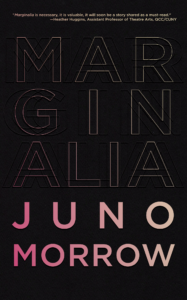
Juno Morrow’s new memoir, Marginalia, is slated for release on June 23rd 2020 from CLASH Books. Marginalia was completed as part of the Faculty Fellowship Publication Program.
Constructed of words, artwork, photos and personal artifacts, Marginalia is an intimate and unconventional account of what it means to be a hybrid. It seamlessly interweaves experience with elements of sociology and psychology, exploring how one cultivates an identity containing multitudes — queer, trans, mixed-race, other.
Juno Morrow is a multidisciplinary artist, independent game designer, photographer and educator living in Brooklyn, New York. She is an Assistant Professor of Game Design and Unit Coordinator at the City University of New York’s Eugenio María de Hostos Community College. At Hostos, she has been developing the game design program, the first public degree program of its kind in New York City, since 2015. Prior to that, Morrow earned an MFA in Design and Technology from Parsons School of Design. As an internationally exhibiting artist and designer, Morrow has presented games and spoken at sites such as SXSW, GDC, MAGFest and the Smithsonian American Art Museum. With over 10 years of experience as an award-winning photographer, she’s had work featured in The Guardian, Dwell magazine and released 3 monographs of urban photography.
Her unusual games, often infused with dark humor, feature distinctive aesthetics and novel premises. Examples include Oral Perspectives, a VR game taking place inside the player’s mouth, and Mastering Tedium, an existentialist laundry simulator played inside a text terminal. Recent work includes Pruuds vs. Sloots, a “dumb versus game,” Blood Broker, a consent-based human sacrifice management simulator, and Marginalia, a memoir examining intersections of mixed-race and transgender identities.


